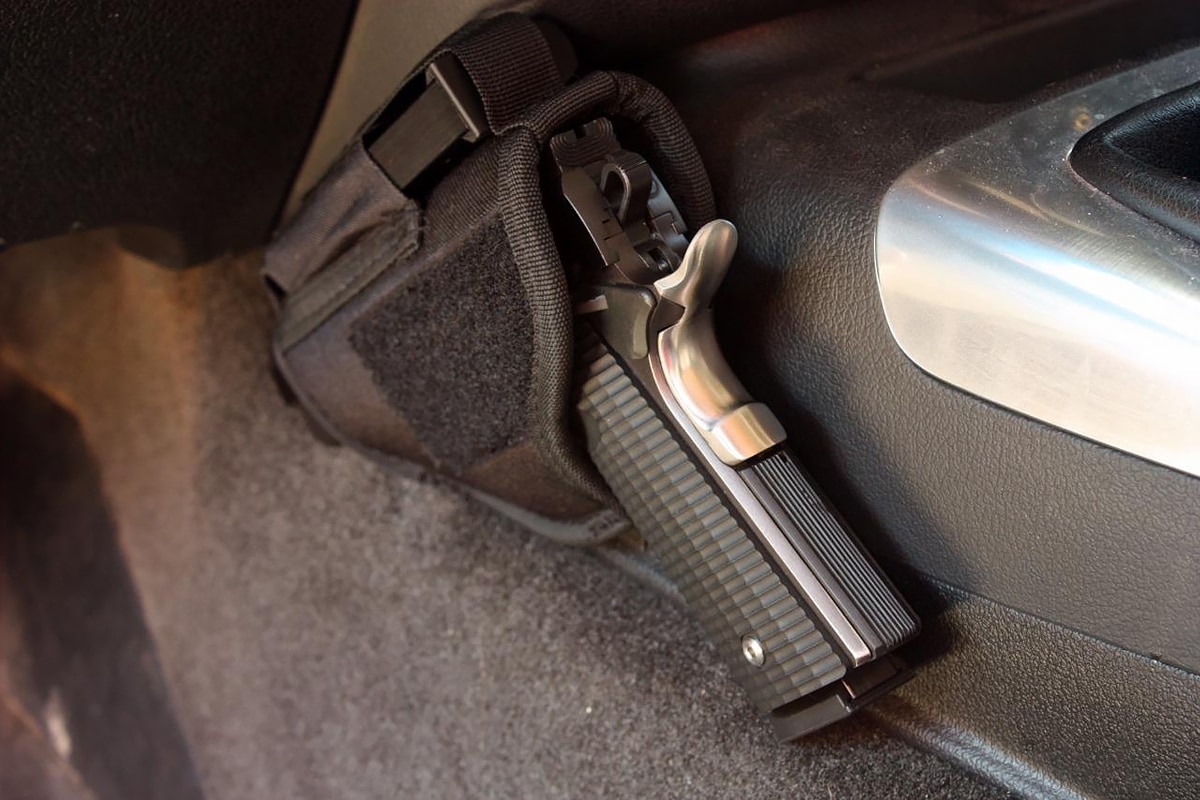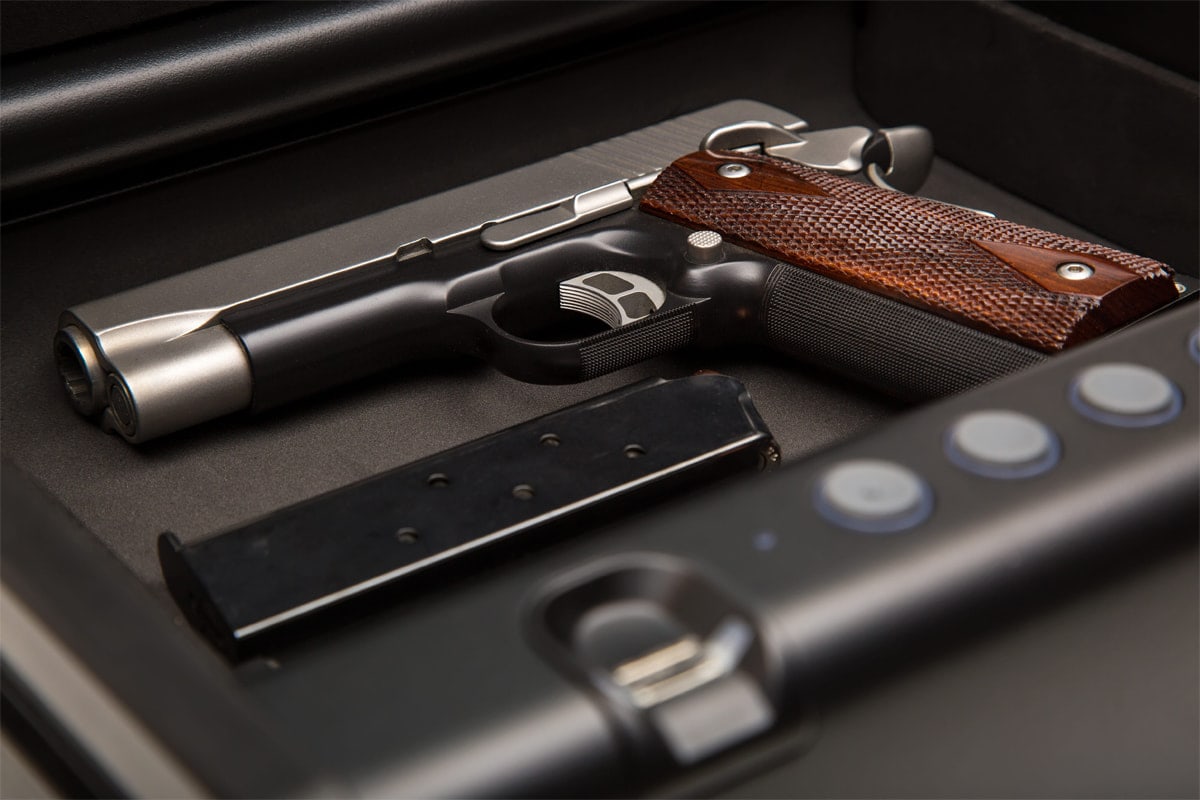If you own firearms, you need a gun safe to protect them securely from unauthorized access by children and criminals. It can be a big investment and there are countless options in the market, such as sizes, safe locks and applications. It’s not easy to choose the best gun safe that meets your needs without deep research.
This definitive gun safe buyer guide includes everything you need to know about gun safes, from what they are, how to use them and common questions. Hope this guide can help you select the best gun safe that works for you.
Gun Safe Sizes
Choosing the right size of your gun safe is one of the most primary decisions to make.
First, let’s look at how safe manufacturers label the gun capacity of their gun safes before going further.
We see many safe manufacturers label their safes with numbers such as the commonly seen “24 gun safe” or “12-18-30 gun safe”.
For the “24 gun safe”, the number 24 means the safe can hold 24 long guns.
For the “12-18-30 gun safe”, the 12 means the left side of the gun safe can hold 12 long guns(usually rifles), the right side can hold 18 long guns(usually shotguns), and the safe can totally hold 12+80=30 long guns.
So a 12 gun safe can store up to 12 firearms or usually as many as 24 handguns at most. But 12 gun safes from different manufacturers usually have their own sizes and may vary a lot in shapes.
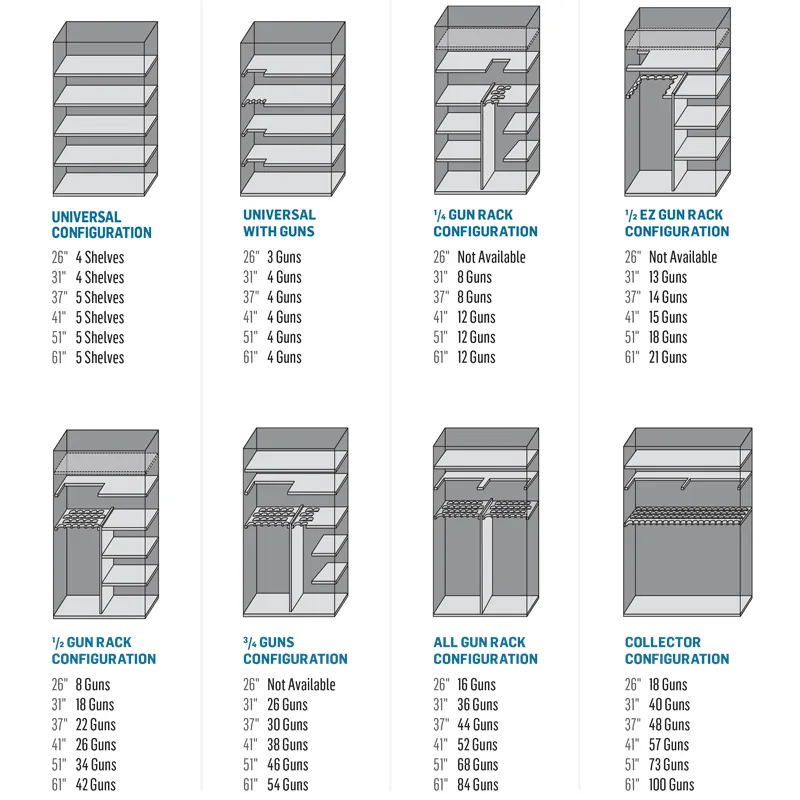
So how many guns can a safe truly hold?
Literally, a 24 gun safe can hold 24 standard-size, unscoped long guns like rifles as labeled, but they are usually packed way too close to each other. Safe manufacturers want to advertise their gun capacity as large as possible to beat the competitors in marketing, so customers should pay more attention to the actual interior space, figuring how many guns it can actually hold. Take the labeled gun capacity only as a reference.
If you want to keep long guns with scope or big guns with protrusions like bolt handles, grips and accessories, the gun capacity drastically decreases. A big firearm might take up the space of 2 or 3 standard guns.
Even if your safe fits all your guns perfectly, filling up a gun safe to its capacity means you’re going to have to move most of the guns in and out to get at any one of them and repeat again till next time. Because all guns are packed together, you cannot simply pick one gun deep inside the safe without first removing other guns. And to close the safe door, you need to put all guns back in the safe again. It’s a pain if you are a frequent user.
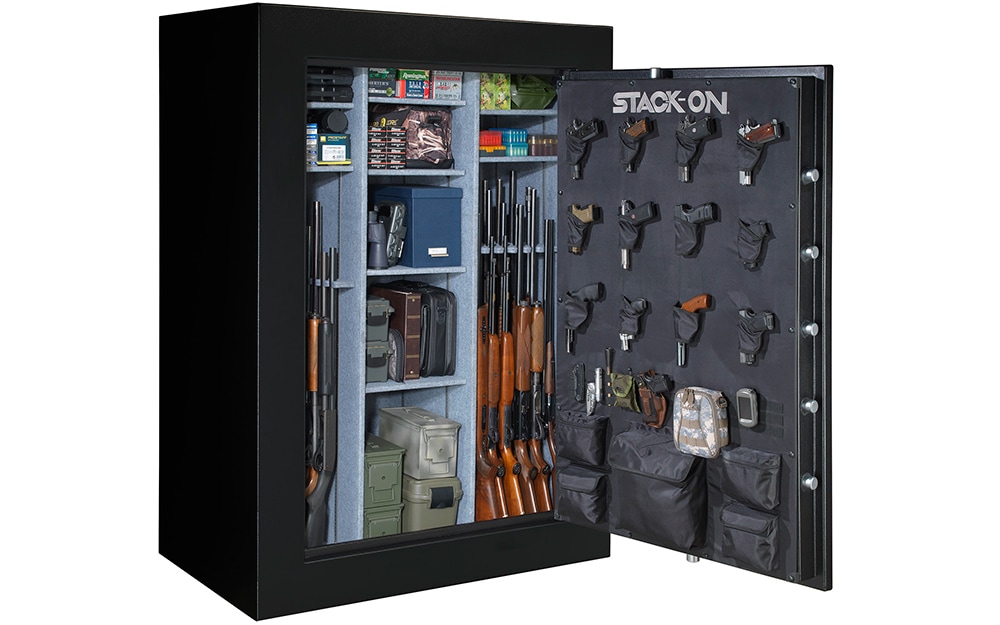
In reality, take the rated gun capacity and divide it by two, that’s the actual number of guns you can put in a gun safe comfortably. You can put 12 long guns in a manufacturer advertised 24 gun safe freely without bashing them together.
So what size of gun safe do I need?
The answer is simple, buy a safe as big as you can afford, preferably two times bigger than you think you might need.
Besides the gun capacity reason we talked about above, here are other reasons why you should consider purchasing a big gun safe.
You will Fill Up Your Safe Quickly
For most gun owners, their gun collection grows. The growing number of guns will eventually take up all the spaces of your safe.
What’s more, guns are unlike other valuables that you can keep somewhere else. If you have a gun, especially a long gun, you have to put it in a gun safe for safety, especially if you have a younger family member or kids at home. You have to prevent kids from getting easy access to guns to avoid tragedy from happening which we’ve already seen too much.
Additionally, there are some people who prefer to put ammunition and gun accessories in the gun safe too. Many people would also put jewelry, important documents in the gun safe and use them as a regular home safe, which makes sense. All these will take up extra space and will fill up your safe very quickly.
Make Sure the Safe Fits Your Longest Gun
Another good reason for getting a large gun safe for now is that some of the guns you might buy in the future may be too long for your current gun safe to hold.
It’s better to buy a safe large enough that is compatible for your future gun upgrades. Even if you don’t need to store long guns, the big safe’s extra space can be used to keep other things like ammo or accessories, it can’t be wasted.
Prepare for the future.
Most People Only Need One Big Gun Safe, Not Two Small Safes
If you buy a small safe, it’s almost impossible for you to expand the safe or add extra room. And to move or relocate a gun safe can be a pain and has an extra cost.
A high-quality, large gun safe can stay in your house for decades, and you can pass it to your kids and grandkids by only upgrading safe locks and interiors.
So the gun safe sizes are totally up to your budget and where you decide to put the safe.
You should look at the safe’s exterior size when deciding where to put or hide your safe.
For depth, usually a gun safe is 26″ to 28″ deep. Width and height may vary a lot and manufacturers provide many sizes for you to choose from.
For height, please note that there is a top shelf inside the safe which takes some room in the safe. In order to put long guns, you should consider 60″ for height at least.
For width, it’s a less critical dimension and is entirely up to how big you need it to be, where you put it and your budget.
Don’t forget to look at the interior size too. The better the fire-resistant and burglar-resistant rating it has, the thicker the walls will be, and the smaller interior spaces left for storing guns.
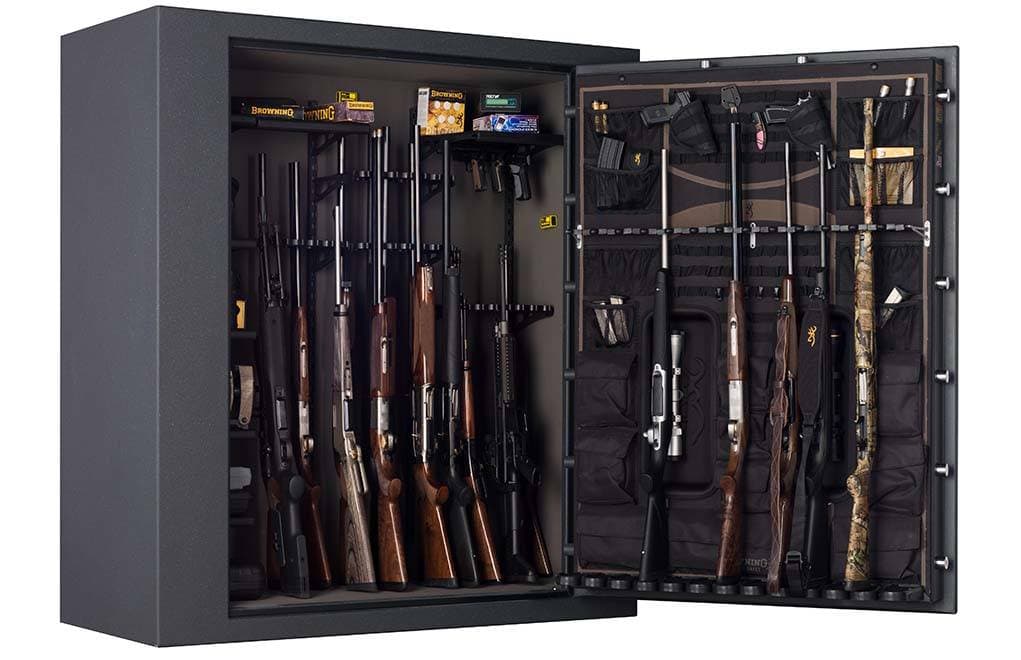
Safes with similar exterior sizes may end up having totally different interior sizes. Compare the inner dimension and your gun length to make sure the safe meets your demand.
Even if you want a small or hidden safe that can be placed where children cannot find it, you should still consider making the inner space as ample as possible.
Gun Safe Weight
Gun safes can weigh from hundreds to thousands of pounds, from 200 to 2,000 lbs. There are commercial grade, fire-proof gun safes that weigh much heavier, depending on the sizes and material used. If a safe contains concrete material for fire-proof, the weight will significantly increase or even get doubled.
Is There a Recommended Safe Weight?
The 750 pounds empty weight is a good range balancing security performance, weight and sizes.
At around 750 lbs, the gun safe size is big enough for gun storage, heavy enough for a couple of thieves not to move with a dolly, and difficult to tip over with its big size and weight.
Whereas a 500 lbs safe is much easier for a couple of thieves to handle when the safe is not bolted down.
Can My Floor Hold a Heavy Gun Safe?
Many people want to buy a large and heavy gun safe, but they wonder if their floor can hold up the weight safely.
The answer is clear, you can put the gun safe on your home floor. Putting a gun safe is no different from placing a refrigerator in your kitchen, are you ever worried about your refrigerator being overweight? Full-size residential refrigerators weigh between 100 and 400 pounds, with an average weight of 250 pounds. You can choose a safe within the safe weight range if you don’t aim for super heavy safes.
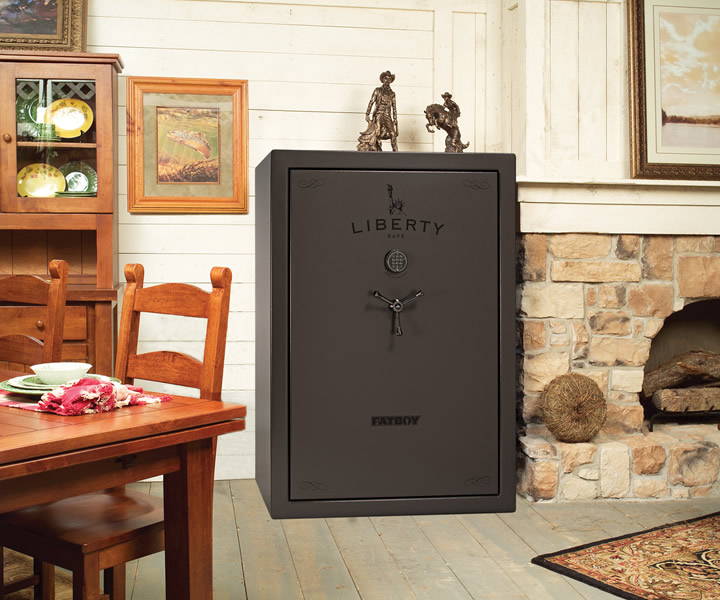
You can quickly do simple and quick math to find out yourself. Calculate how much space your favored gun safe occupies and google how much load your home floor can take for such area, you will get yourself an answer.
Gun Safe Types
There are various types of gun safes catered to specific needs, and not all gun safes serve the same purpose. Customers should choose the most suitable safe that meets their actual demand.
Gun Safes
A typical gun safe is heavy with thick walls, usually fire-resistant and equipped with a mechanical or electronic combination lock rather than only a key lock.
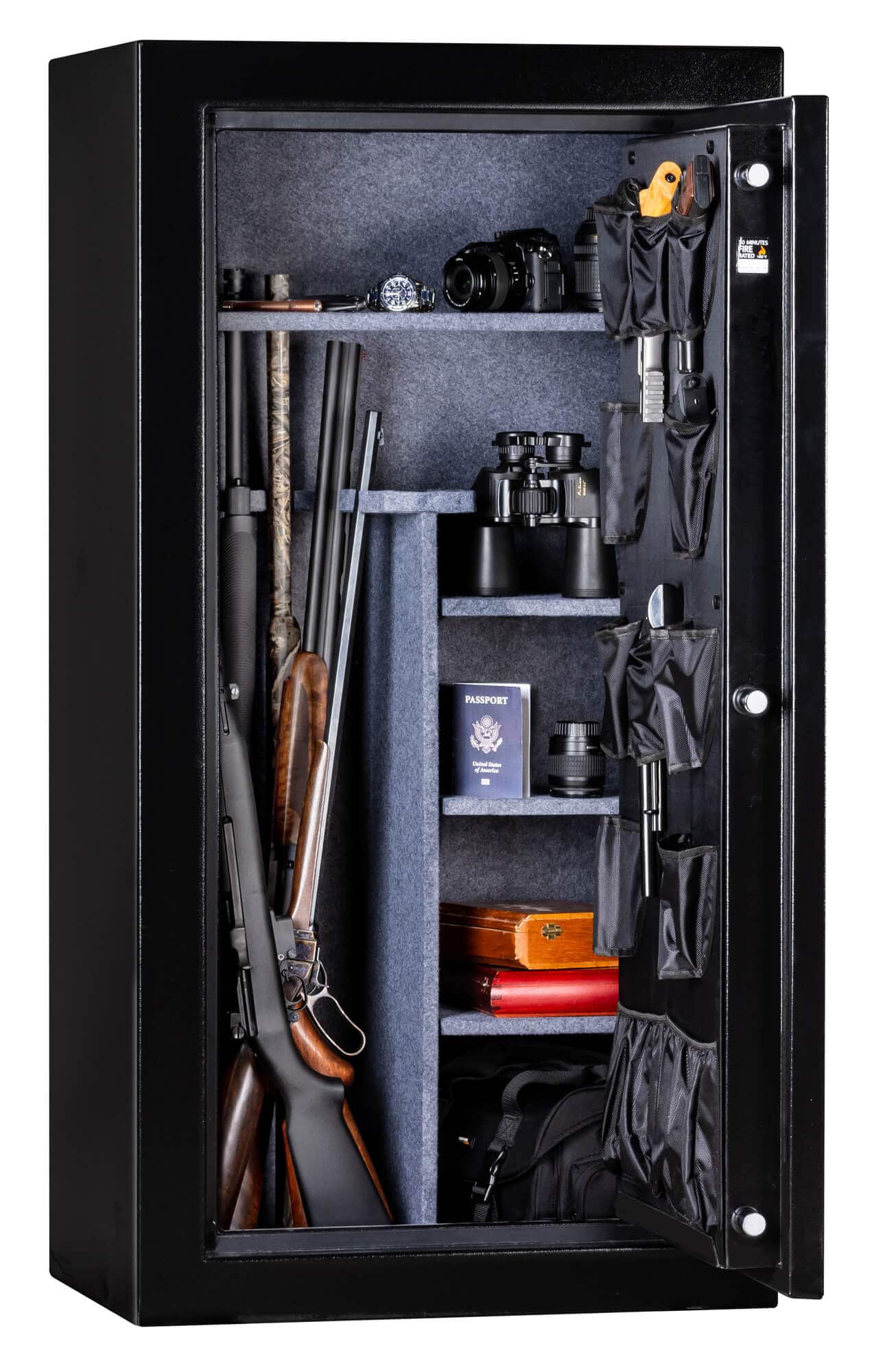
These gun safes are specially tailor-made to provide high-security protection for guns and firearms and are usually certified with anti-burglary and anti-fire certifications. Even a small gun safe can weigh a couple of hundred pounds.
Gun Cabinets
A gun cabinet or gun locker is a lightweight security storage unit for guns. Gun cabinets can weigh as light as 50 lbs to be used where a gun safe might be too heavy, such as being installed on an apartment floor or bolted down for higher security.
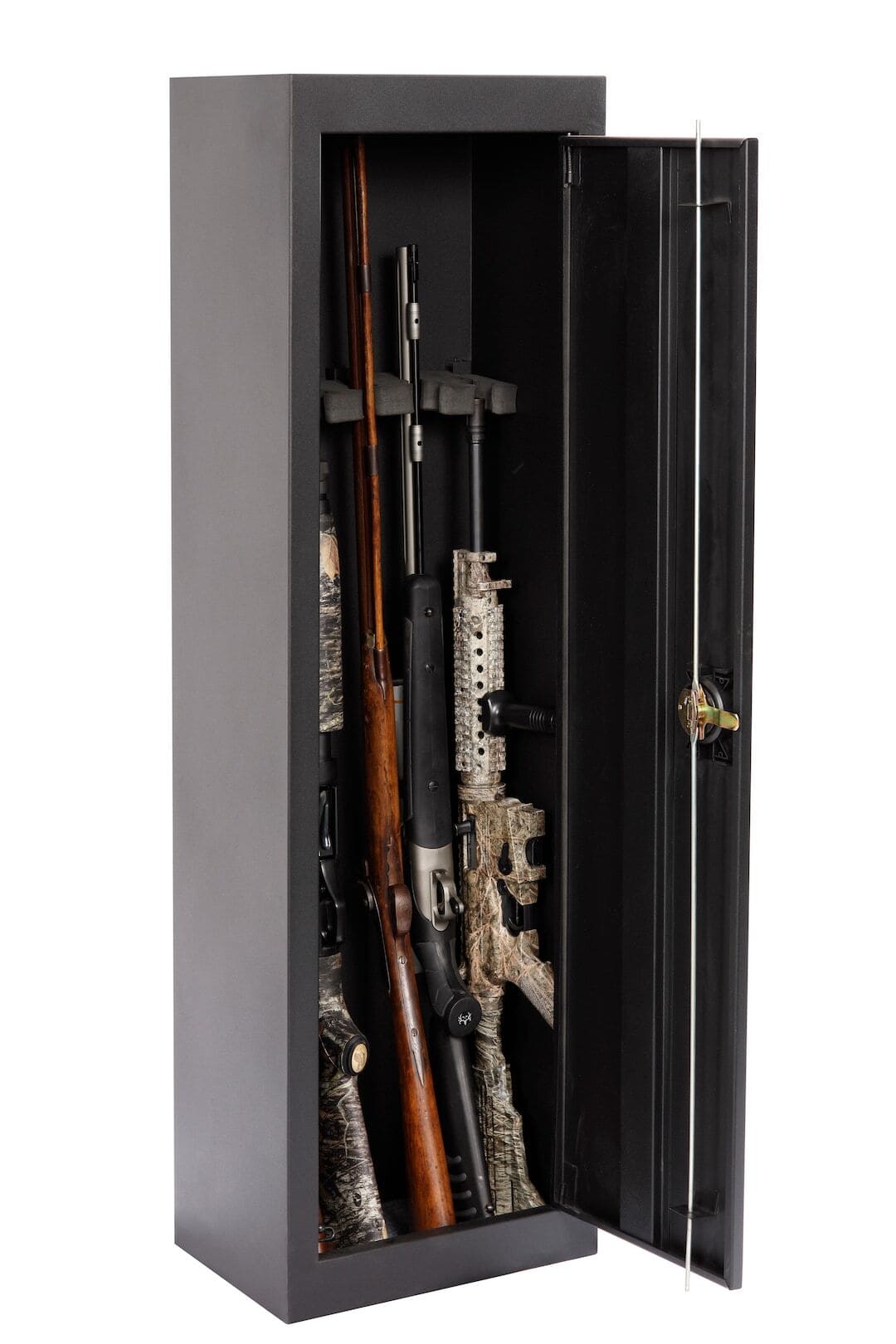
Gun cabinets are meant to provide decent gun storage with at least a medium level of security protection with quick access and easy management, so key locks are often seen used on a gun cabinet. Gun cabinets do not aim for high-security protection as the priority, so they usually don’t have fire-proof certification.
Handgun Safes
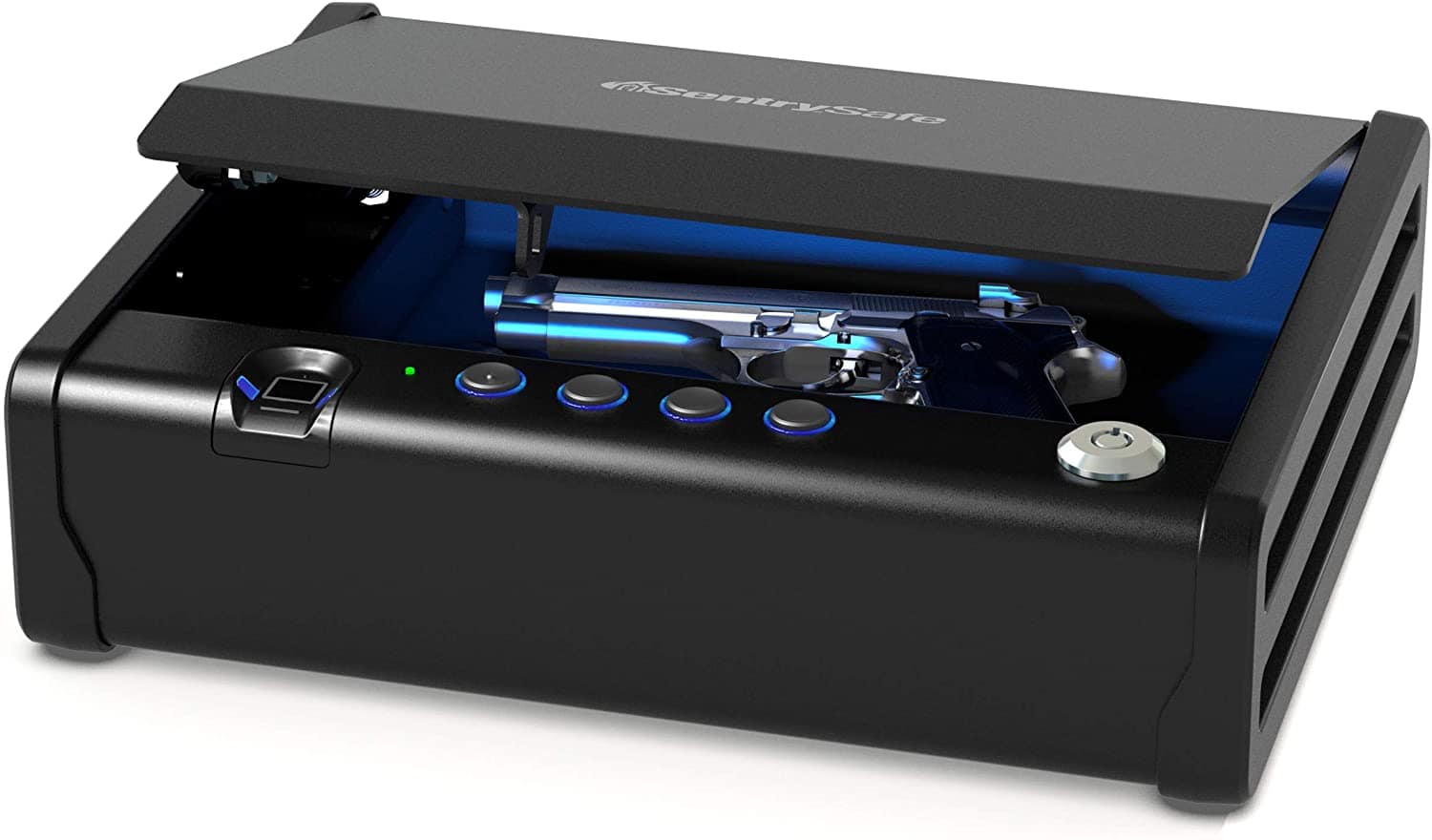
A handgun safe is usually small and portable, designed to hold one or two guns that can be carried away with the owner. There are also larger handgun safes designed for vehicles to hold one or several guns. Handgun safes are often equipped with digital or biometric locks for quick access.
Long Gun Safes
Long gun safes are the main gun safe type we talk about here. They are usually 60″ tall to keep 10 to 30 + long guns.
Quick Access Safes
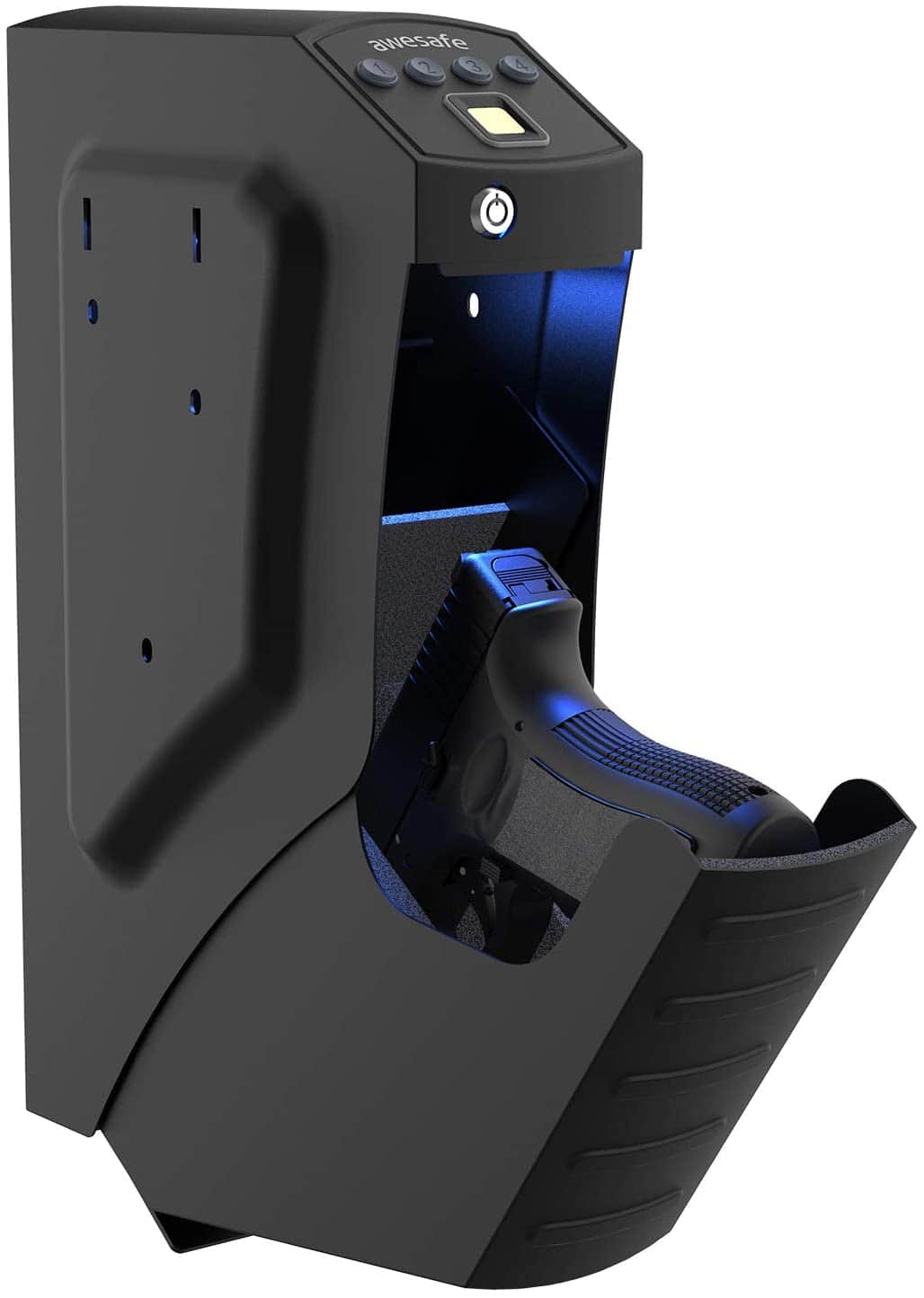
Quick access gun safes are usually bedside safes that you can get a gun in a short time in case a burglary happens.
Hidden Gun Safes
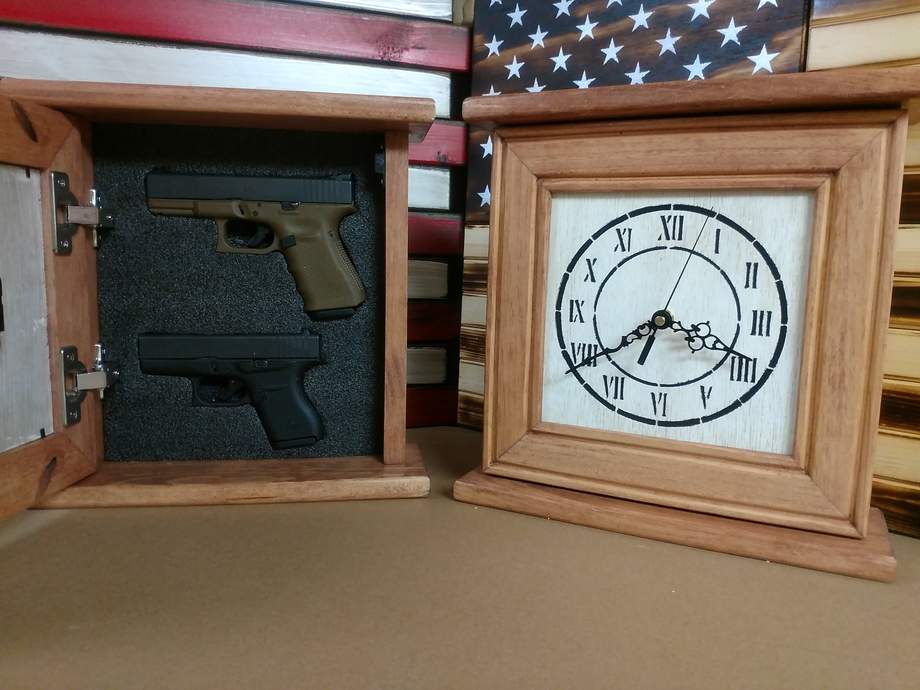
Hidden gun safes are usually a wall safe, floor safe, clock safe that cannot be spotted except the owner. A hidden gun safe can be helpful in many cases.
Gun Safe Locks
The gun safe locks are a significant part to be taken into consideration when selecting the optimal safe because they determine how you open your safes. Normally there are three access methods: mechanical combination lock, electronic lock and biometric lock. Key locks are usually seen used on cheap gun safes or gun cabinets, they are also used as an override backup access when the main lock fails.
Don’t worry, most of the gun safe locks are interchangeable as they share the same installation dimensions. You can freely change from a mechanical lock to an electronic lock or vice versa if you are not comfortable with the current lock or need a lock improvement.
Mechanical Locks
Mechanical locks are traditional, time-proven, and highly reliable. To open the lock, you need to spin the dial left and right three times(or four times depending on wheel numbers of the lock)to unlock the door. Most dial locks have a key lock on the dial for extra protection to prevent the dial from spinning, so people cannot manipulate the dial to try out your combination.
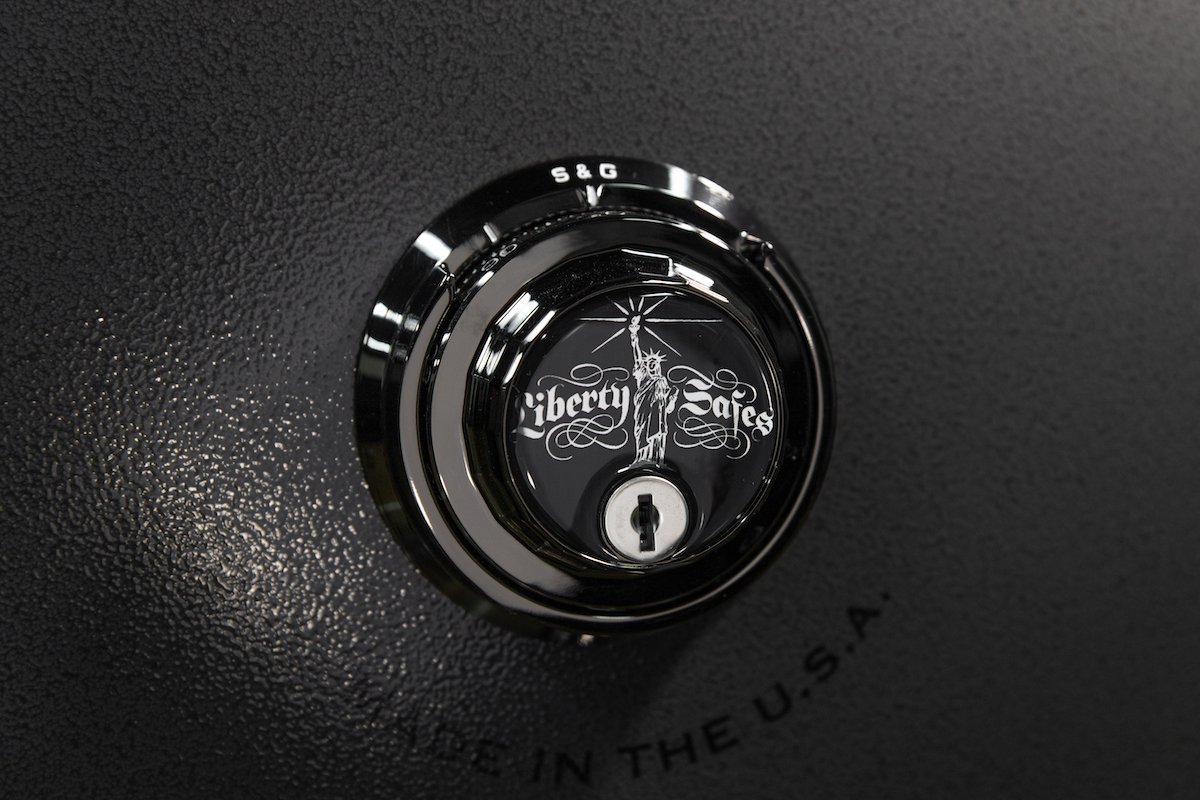
With proper usage and service, the mechanical lock can be the most reliable and universal lock option for gun safes. It may take a longer time to open mechanical locks, especially when you need to access your guns in a hurry. But with proper practices, or you are a frequent user, you can open mechanical dial locks pretty fast too.
Remember, the mechanical lock does not lock itself automatically. When you close the safe door, you need to spin the dial to get it locked again.
Electronic Locks
Electronic locks are favored by most users nowadays as they are fast to open, easy to use and have a lot of practical functions. Though cheap electronic locks still have bugs and they randomly fail, but the premium electronic locks have improved a lot over the last decade and they are incredibly reliable and can provide higher security than mechanical locks.
Normally, users can set their own combinations and set multiple user codes for lock management. The wrong try penalty feature can make your gun safe more secure by preventing your password from getting tried out.
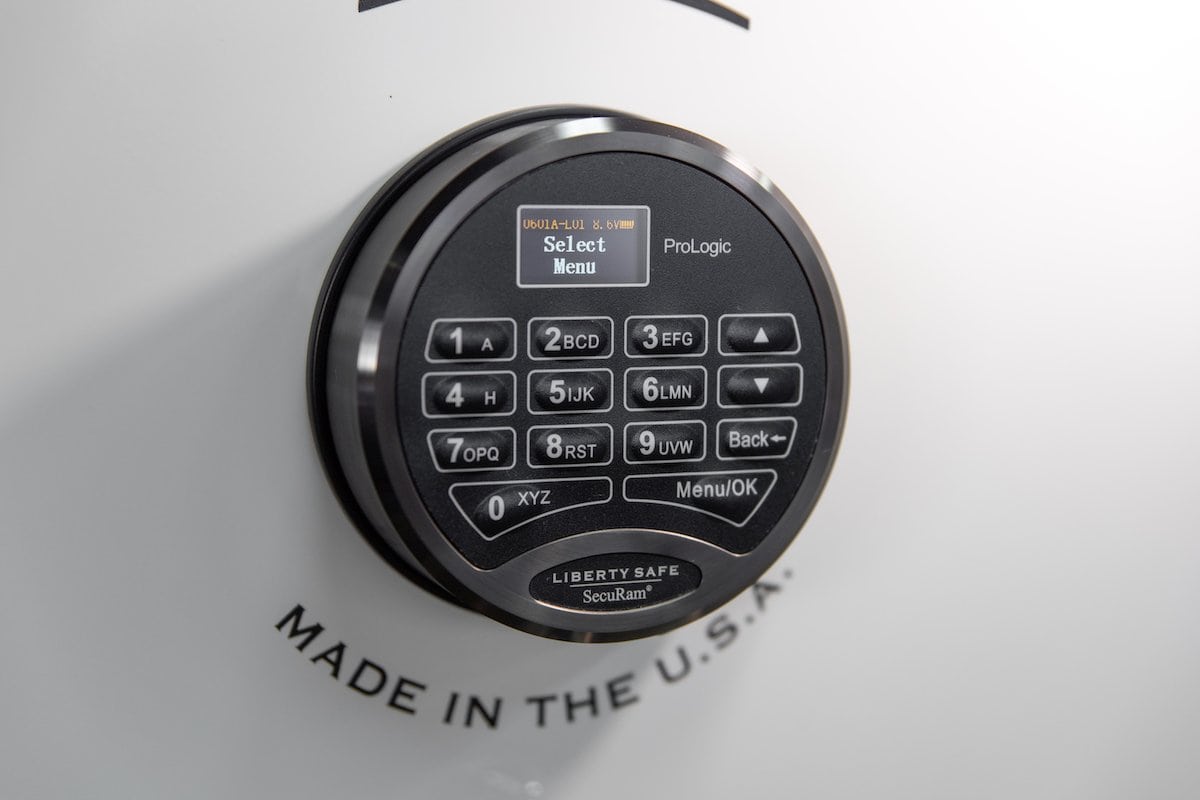
The common thing people worry about electronic locks is the battery. If the battery fails, users cannot open the gun safe. But actually, it’s not a thing to worry about.
Most electronic locks have a low power indicator to remind you to change the battery ahead of time. And most batteries are located on the keypad, outside the safe door. So even the battery dies, users can change batteries quickly. All passwords are stored inside the lock with a built-in battery, so your passwords won’t be lost even if the battery dies for a long time.
Change the Battery of an Electronic Lock
Most batteries are installed on the keypad so users can still replace the battery when they cannot open the safe door.
For some locks, you need to hold the keypad then and rotate the keypad to remove the cover and change batteries.
For some locks, you can find a small sliding door under the keypad and you can find the battery there.
These are the most common ways how locks locate their battery. Try and test how your lock stores the battery.
Though it only takes a few minutes to replace the battery, it still means you cannot access your guns when you need them most in an emergency if the battery dies. So keep an eye for the battery level and change them when needed.
If you are worried about EMP attacks, there are EMP-proof electronic locks on the market to help your electronic locks survive the attack.
Biometric Locks
Biometric locks or fingerprint locks are a kind of electronic lock that offers fingerprint access. Users can set up the lock to accept fingerprint-only access or use the combination code to open the lock.
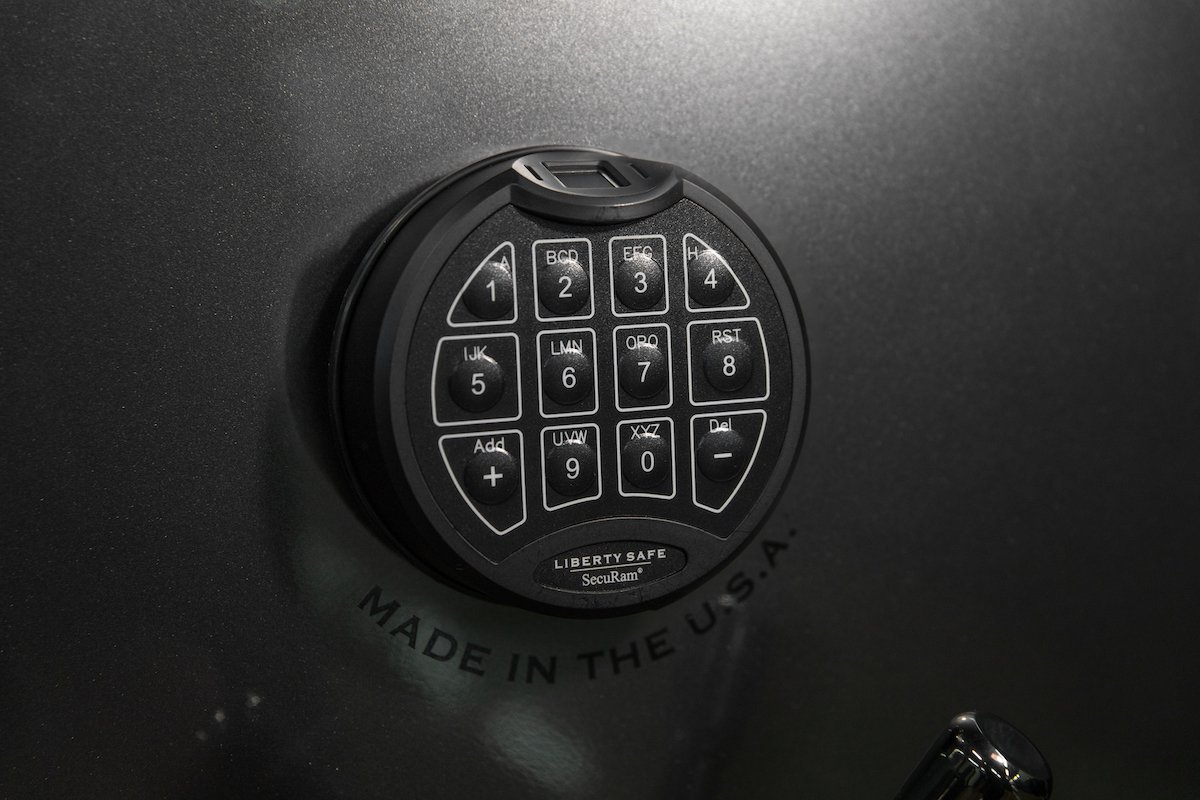
Fingerprint locks are similar to keypad locks, they are meant for quick access. But for most fingerprint locks, the technology is not perfect yet. If your hands are dirty, you might have to try several times before your fingerprint gets recognized by the lock scanner.
Fingerprint access usually comes with an electronic keypad lock and should always have a combination code to bypass in case your fingerprints cannot be accepted.
Redundant Locks and Override locks
If your electronic lock fails, you have to drill open your safe or ask a locksmith to open the lock. If you add another lock as a backup plan, usually a key lock, to override the failed electronic lock, you might still open the safe using the key lock. Usually the keyhole is hidden behind the keypad so people would not know you have a key lock installed.
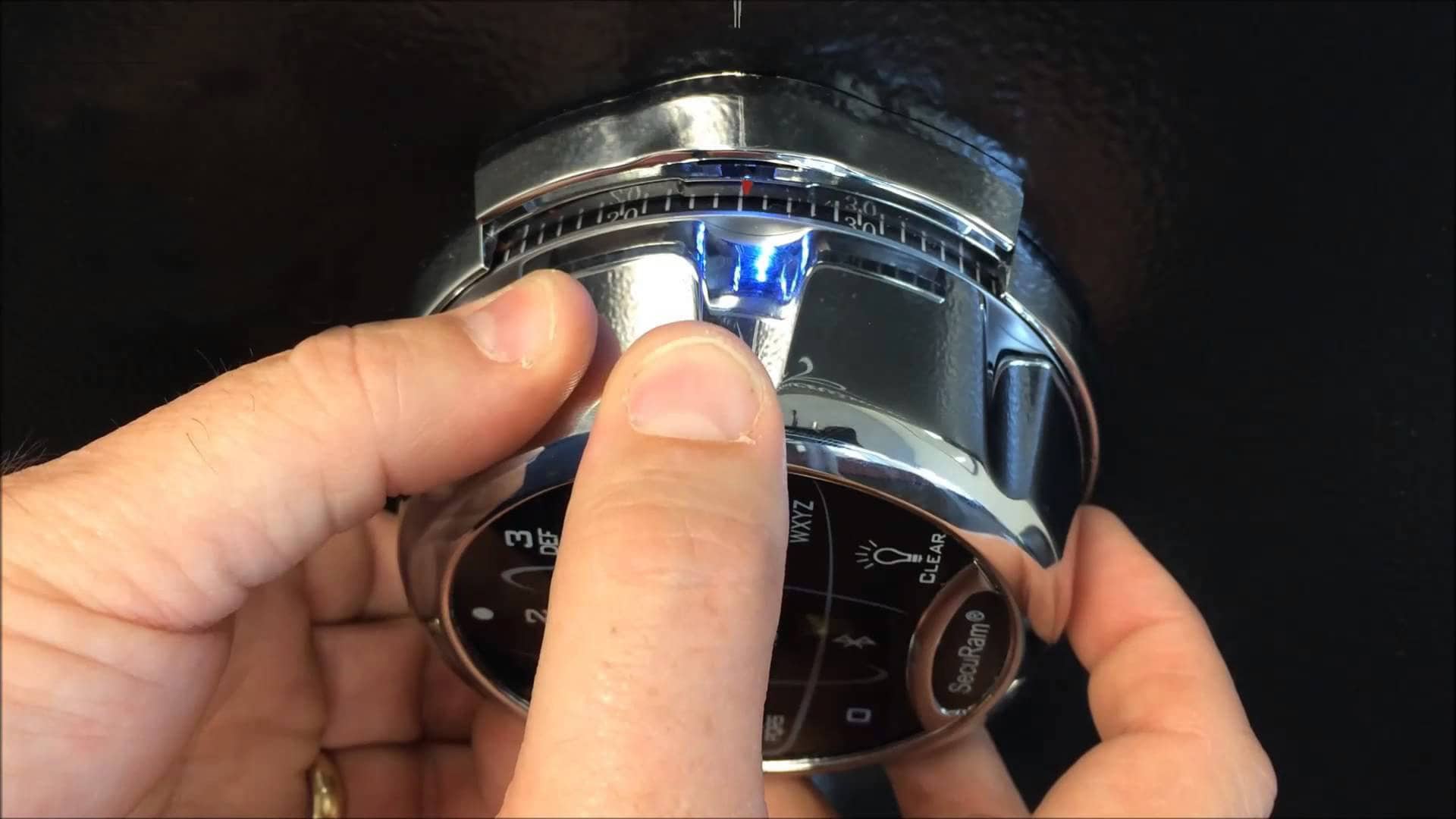
Redundant locks are similar, but they are usually a mechanical combination lock built-in with an electronic lock. So if the electronic lock fails, users can use the mechanical combination lock to get the lock open.
Key Locks
Key locks are not often used on gun safes, but they are mostly seen used on gun cabinets for quick access and user management. Key locks can be extremely high security, the biggest reason that key locks are not preferred these days is that users have to keep the keys secure too.
Key locks are also used as the secondary lock to override the main electronic lock as the backup plan if you forget the combination or the electronic lock fails on high-security safes.
How to Change Lock
When the lock fails, damaged or you want an upgrade, you want to change or replace the lock. Changing the lock is easy, as most gun safe locks share standard mounting dimensions, allowing you to replace the locks without effort.
To change the lock, you need to open your safe first and remove the back cover of the safe door. Then you can follow the instruction manual of your newly bought safe lock and switch them.
For most locks, the replacement of electronic locks and key locks is very easy, you can do it on your own. Some mechanical locks require some skill to install, but you can still get it done by strictly following the lock’s instructions. If you cannot handle them, you can call a locksmith for the job.
How to Open Gun Safe
If you are using an electronic or fingerprint lock, you can simply input the correct code or fingerprint to get it open. Some locks may have different enter key as * or #, you need to follow the user manual.
If you are using a key lock, insert the correct key to get it open.
If you are using a mechanical combination lock, you can follow the instruction here.
If you find a keyhole on your safe combination lock, you need to insert the key to unlock the dial first.
Open A 3-Wheel Safe Combination Lock
If your combination has 3 numbers, then you are using a 3-wheel combination lock.
- Turn the dial to the Left(CCW), stop when your first number comes under the opening mark the 4th time.
- Turn the dial to the Right(CW), stop when your second number comes under the opening mark the 3rd time.
- Turn the dial to the Left(CCW), stop when your third number comes under the opening mark the 2nd time.
- Now the combination is entered, turn the dial slowly to the Right until it stops to unlock and retract the bolt.
Open A 4-Wheel Safe Combination Lock
If your combination has 4 numbers, then you are using a 4-wheel combination lock.
- Turn the dial to the Right(CW), stop when your first number comes under the opening mark the 5th time.
- Turn the dial to the Left(CCW), stop when your second number comes under the opening mark the 4th time.
- Turn the dial to the Right(CW), stop when your third number comes under the opening mark the 3rd time.
- Turn the dial to the Left(CCW), stop when your fourth number comes under the opening mark the 2nd time.
- Now the combination is entered, turn the dial slowly to the Right until it stops to unlock and retract the bolt.
Notes:
If you accidentally pass the correct number, you cannot turn back the dial and should start all over from the beginning.
Gun Safe Door
The burglary attack happens, the first place they target is the lock and door. Make sure the safe door is as strong as possible when deciding which safe to purchase.
Door and Door Frame
One of the first things to look at and also one of the weakest areas is the gun safe door. The thicker the safe door is, the better the anti-burglary resistance it provides.
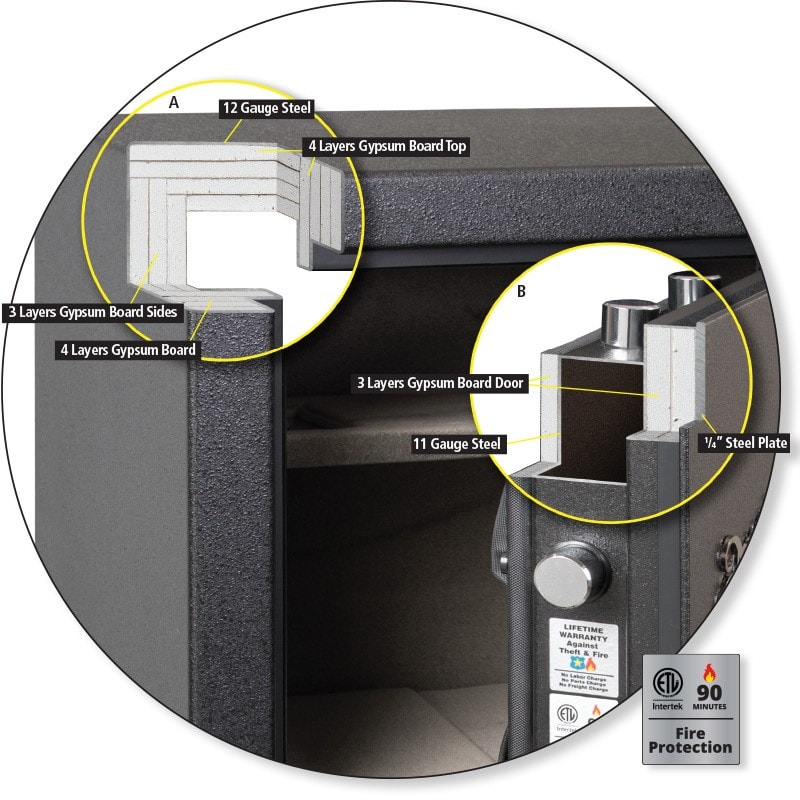
There are some door plates made with pure solid steel which provide super strong protection. And there are layered door constructions with thin steel plate and material inside to make it look thick. A solid steel door plate is highly preferable to a door plate with thin steel layers even it might look thinner.
Pay attention to the door frame material, don’t get tricked by weak door frames which are only visually thick.
Additionally, you can choose a recessed door over a regular one because it’s even harder to pry open the door when it’s recessed.
Door Gap
The small door gap is the most crucial factor that thwarts pry attacks. Most basic to medium gun safes have huge door gaps which are fairly easy to get a pry bar in. That’s bad.
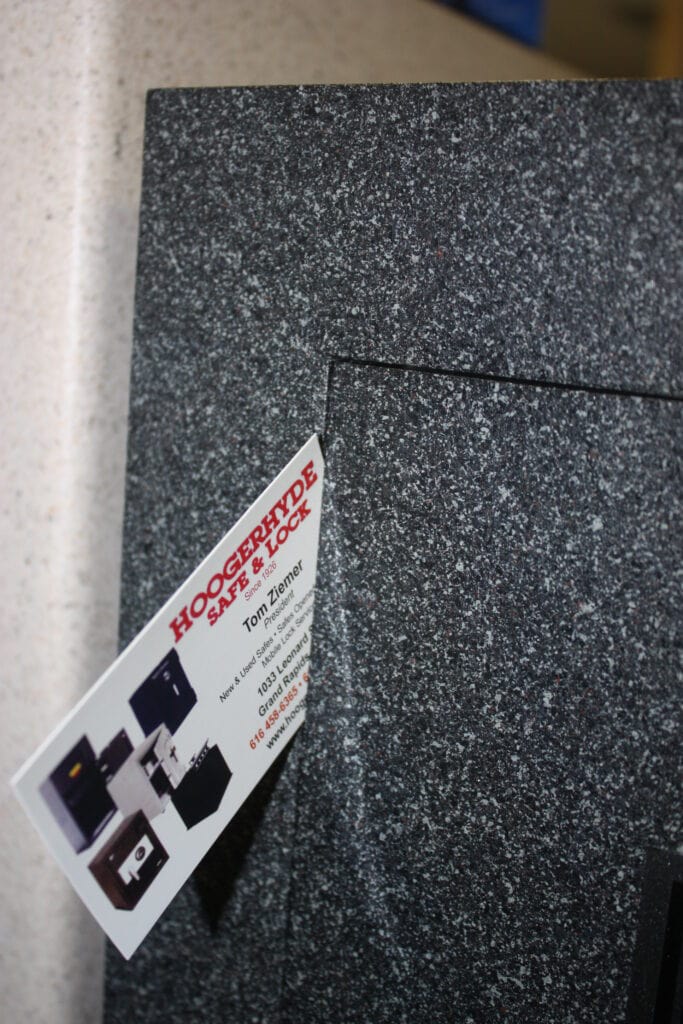
If the door gap is so thin that you cannot even insert a card between the door and jamb, how can anybody pry attack your safe? The possibility of getting a pry attack would be nearly zero.
Door Seal
A door seal is mainly to help prevent the hot gas, smoke, and firefighting water spray from outside the safe from getting inside and damaging your guns and assets in case of a fire. The door seal can also help the dehumidifier to be more efficient in keeping the moisture off of your weapons inside the safe.
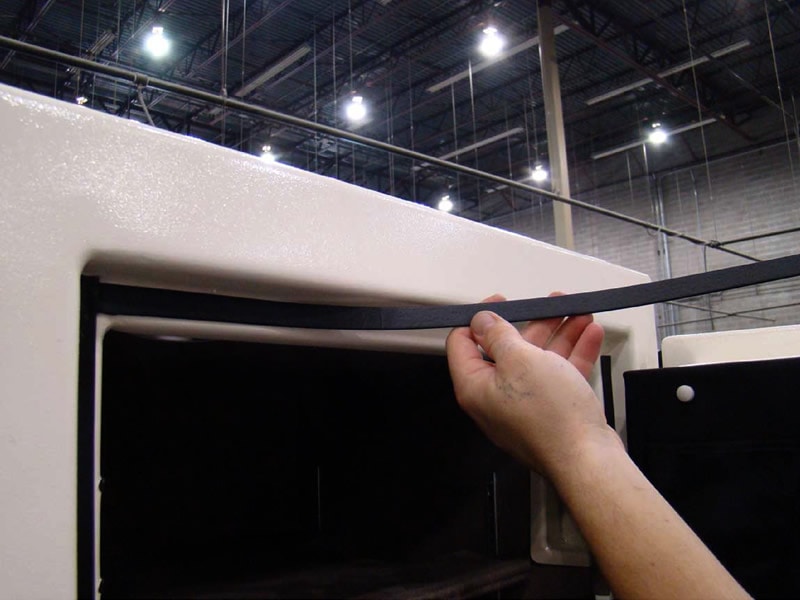
To keep the moisture and fire away is critical for every gun safe owner. Consider using a good door seal to protect your guns in the long run.
Can the door be removed?
Yes, if the gun safe has exterior hinges, the doors can be removed to significantly cut off the weight and exterior sizes when moving the safe upstairs/downstairs and through doorways.
After the safe door is removed, the safe’s weight is lightened to be able to be transported by 2 or 3 men and the size can clear most of the main entrance without much effort. Then you can reattach the door back after you’ve correctly removed and relocated the safe.
Gun Safe Hinges
The internal hinge and external hinge have nothing to do with the security performance if they are all properly made. But there are some differences for you to consider.
Internal Hinge
- Internal hinges look modern and integrated.
- Internal hinges only open 90 degrees.
- Internal hinge doors can’t be removed or adjusted.
- Some fire-proof lining might be cut off on the hinge side for the door to closely shut.
- Heavily swinging the door might damage the hinges and door jamb.
External Hinge
- External hinges give a traditional look.
- External hinges allow the door to swing open 180 degrees which provides more spaces for users to arrange things.
- External hinge doors can be removed and adjusted. The doors can be removed to reduce the safe’s weight when moving and can be serviced when out of alignment.
Gun Safe Bolts
Most gun safes use 3-way bolt work. When we turn the safe handle to open the door, only bolts on three sides will retract to release the door: top, bottom, and the side opposite to the hinge. These moveable bolts are called live bolts. Similarly, when we turn the safe handle to close the door, the live bolts on the three sides will extend to keep the door shut. The bolts on the hinge side are static and not moveable, they are called dead bolts. The dead bolts are only used on the hinge side and can keep the door shut even when the exterior hinges are cut off.
There are gun safes that use 4-way bolt work with live bolts on all four sides too. Some manufacturers claim that 4-way bolt work are more secure but you shouldn’t pay much attention to it. When it comes to how the bolts protect your safe, 3-way and 4-way do not matter that much.
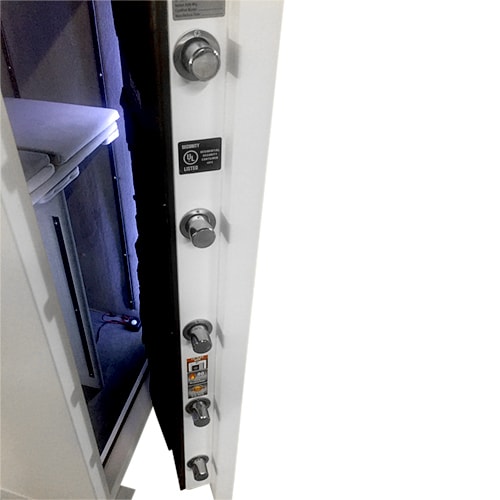
As for the number of bolts, it doesn’t necessarily mean the more, the better. The more bolts the safe has only means the higher cost you will pay.
When your safe door is thick enough, the thick safe door plate itself can effectively protect your safe against pry attacks where the number of bolts provides little to no help.
If the safe door plate is too thin, then the number of bolts does help to prevent the door from bending under pry attacks. When you are not able to find a safe with thicker walls, then you should definitely look for the safes with more live and dead bolts.
You may notice that there are square bar bolts and traditional round bolts used in safes. In short words, they are all safe when the bolts are properly made by legit manufacturers. Pick what you feel comfortable with.
Gun Safe Interiors
Configuring the interiors of your gun safe has become an art recently. To make your safe optimized for the best performance and tailored to your demands, here are some essential things that can help you organize your safe interiors.
Shelf
If you want to organize your interior room, choose a safe with adjustable shelves. You can configure the interior area with movable shelves to customize to your needs.
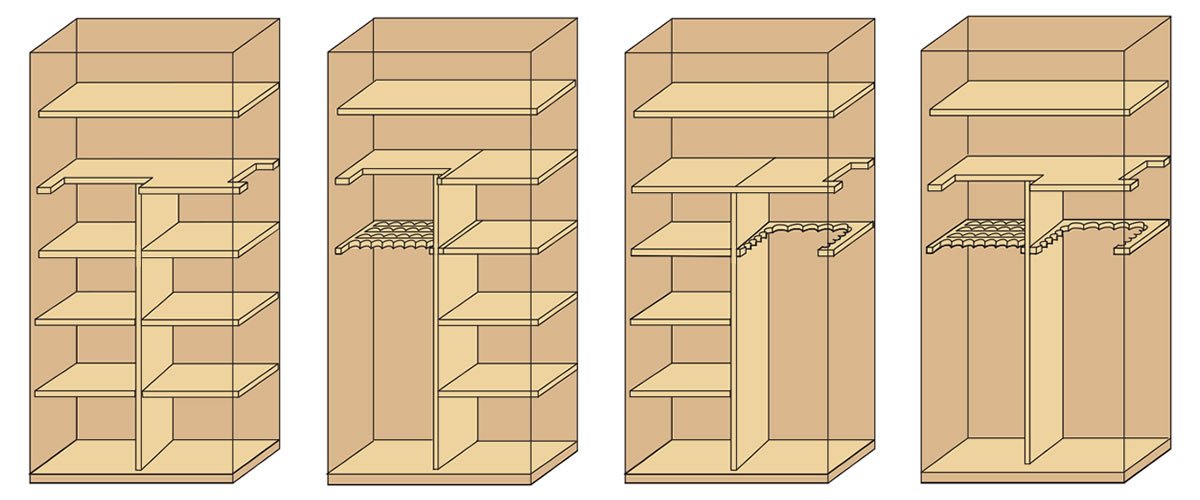
The shelves are often sturdy, too much weight might warp the shelves over time. Disperse the weight for the longer benefit.
Movable shelves can be as strong as fixed shelves, you don’t have to buy fixed shelves for stability。
Interior Lighting
It’s recommended to have the factory default lighting as they fit better to your safe. You can add your lighting system later. It’s all up to you.
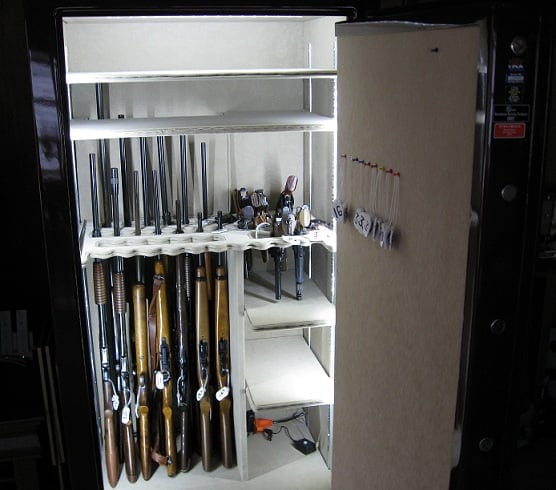
But don’t skip the interior lighting part, thinking it’s unnecessary because you have enough lighting in the room. Interior lighting is always useful, especially in the middle of the night, where the lighting in the room is never ample. And it’s really dark in the safe even when it’s daylight.
Why is there a hole in the back of the safe?
There is a hole drilled in the back of the gun safe, for the wire to in and out easily for your interior lighting and electric dehumidifier.
Some holes are only pre-drilled from outside in case some users would not use the feature. If you want to use the wires through the hole, double-check it and make sure it’s drilled through.
Gun Safe Dehumidifier
How to Keep Moisture Out of Gun Safe?
Do you see white dust on your guns and gun safes? It’s mold caused by dampness and moisture. Moisture can do great damage to your ammunition and guns, it’s a priority to keep your interiors dry, particularly if you live in a damp climate.
There are several ways to keep the humidity out of your safe.
Desiccant
A desiccant is a chemical that absorbs moisture from the air with a color code indicator to let you know how much water the desiccant has absorbed. You have to empty and dry at certain points for full effectiveness to prevent the over absorbed water from leaking to damage your contents.
You need to be careful if you need certain humidity inside the safe for the wood stocks from cracking if some of your firearms have wood components. Desiccant simply absorbs water, it does not know when to stop.
Desiccants can be a good option for moisture absorption when an electrical outlet is not available inside the safe, but there are rechargeable dehumidifiers that can take care of it too.
Dehumidifier Rods
Dehumidifier rods are electric heating elements to keep the moisture from condensing and keep the humidity at a certain level. There are wired and rechargeable types for you to choose in case you don’t’ have electricity available.
They are also non-toxic, spill-free and very functional. Dehumidifier rods could be an excellent choice for every gun owner.
Light Bulbs
Some people use an old-school light bulb in the gun safe to keep the moisture off. But they are constantly consuming too much electricity and are too hot to be touched. Users should consider avoiding using light bulbs as a dehumidifier.
How Much for a Gun Safe?
Let’s be honest, not everyone wants the same safe with the same budget for the same purpose.
If you are short on money, go with your budget.
If you want to make an excellent long-term investment in your gun safes, there is a general concept you can follow.
Your safe’s price should be at least 10% of the value of the contents(guns, valuables, assets) stored inside the safe. For example, if you want to protect guns valued at $10000, your safe’s retail price should be at least $1000.
Warranty
When buying a safe, pick a safe with a long warranty policy because it shows that the manufacturers are confident in their products.
Many safe manufacturers offer a transferable warranty, so the safes are still covered by the original warranty even when you sell your safes or pass it down to your family members. It’ll make it easier to resell your safes for an upgrade if you can transfer the warranty to your buyer directly.
While safe manufacturers may offer different warranty policies from 2 years to lifetime, they often provide extended warranty options for you to purchase. And each manufacturer’s warranty policy may cover various aspects, like repairing, replacing, relocation, etc. Take a close look at the warranty and make sure what you care about most is fully covered.
We’d recommend at least extending the safe lock warranty to several years as the electronic locks might fail or get damaged eventually without proper usage.
Certification
The Construction Class
The burglar-resistive classification is an industry construction rating established by the insurance industry(Insurance Services Office, also known as ISO) to develop a standard that will indicate the degree of protection a safe will provide against burglary attacks.
But don’t be mistaken, this is only a construction rating, not an insurance rating. Any given safe that meets the construction requirement can be rated under the construction rating without even getting tested.
Each safe, chest or cabinet must be equipped with at least one combination lock except a safe or chest equipped with a UL listed key lock.
Common construction/insurance rating includes:
- B-rated safe: door steel less than 1″ thick and body(wall) steel less than 1/2″ thick.
- C-rated safe: door steel at least 1″ thick and body(wall) at least 1/2″ thick.
- E-rated safe: door steel at least 1-1/2″ thick and body(wall) at least 1″ thick.
- ER-rated safe: equals TL-15 tool-resistant safe
- F-rated safe: equals TL-30 tool-resistant safe
UL1037 for Antitheft Alarms and Devices
As the name antitheft alarms and devices suggests, UL 1037 standard covers a massive number of products. So it’s a general burglary-resistant certification for security devices, not a standard specifically made for rating safes.
The residential security containers(RSC) covered in the standard, can be used to store important papers, valuables, and of course guns. Additionally, the “antitheft” means ul 1037 standard is a burglary resistant standard only, not covering fire resistance tests.
Like other UL ratings, UL 1037 has three tiers of levels:
- RSC-I safe: Attack level one requires the product to withstand a five-minute attack by one technician using common hand tools such as drills, screwdrivers and hammers. If the product successfully performs to the minimum requirements, it is eligible for certification.
- RSC-II safe: Attack level two products must be able to withstand a ten-minute attack by two technicians who use more aggressive tools such as picks, high-speed carbide drills and pressure applying devices. RSC-II security containers shall weigh at least 750 pounds and to be anchored. In addition, the technicians will attempt to make a six-square-inch opening in the door or the front face of the gun safe; the product must resist their efforts.
- RSC-III safe: Attack level three also gives two technicians a ten-minute window to perform the test, but the range of tools becomes even more aggressive. Additionally, the size of the maximum attack opening shrinks significantly from six-square-inches to two-square-inches.
Ul 687 for Burglary-Resistant safes
UL 687 is the standard to rate safes against tool attacks. If you need a burglary-resistant safe, you should look for UL 687 certification first.
UL 687 rating explained:
Test attack against the safe door and front face:
- Tool-resistant safe: Class TL-15
- Tool-resistant safe: Class TL-30
- Torch and Tool-resistant safe: Class TRTL-30
Test attack against door and body, six-sided:
- Tool-resistant safe: Class TL-15X6
- Tool-resistant safe: Class TL-30X6
- Torch and Tool-resistant safe: Class TRTL-15X6
- Torch and Tool-resistant safe: Class TRTL-30X6
- Torch and Tool-resistant safe: Class TRTL-60X6
- Torch, Explosive and Tool-resistant safe: Class TXTL-60X6
For example, Class TL-30 means the door successfully resists entry for a net working time of 30 minutes when attacked with tools like common hand tools, picking tools, electric tools and other testing tools.
For TL class: entry means opening the door or making a 6 square inch opening entirely through the door or body.
For TRTL and TXTL class: entry means opening the door or making a 2 square inch opening entirely through the door or body.
Ul 72 standard for safety tests for fire resistance of record protection equipment
Ul 72 for Fire Resistance of Record Protection Equipment
UL 72 is the fire-resistant certification for safes, including fire endurance tests, fire and impact tests and explosion tests.
For regular users, you don’t have to go deeply into how they test the safes, you need only need to know what their label means to have a decent understanding when choosing a fire-proof safe.
In short, UL tests the fire resistance by exposing the safe to a fire at a certain temperature for certain hours, and the interior temperature should maintain less than the given temperature.
For example, a “Class 350 – 1h” certification means, the safe is exposed to 1700 °F(927°C) for an hour(the test temperatures vary according to class and hour), and the interior temperature should maintain less than 350 °F(177°C).
There are three levels:
- Class 125 – 4, 3, 2, 1, ½ h
- Class 150 – 4, 3, 2, 1, ½ h
- Class 300 – 4, 3, 2, 1, ½ h
For Class 125 and class 150 certification, there are additional requests for interior humidity to be less than 80% and 85% during the fire and cooling period, as the Class 125 and 150 are usually certified for data safes which the content is more sensitive to humidity.






